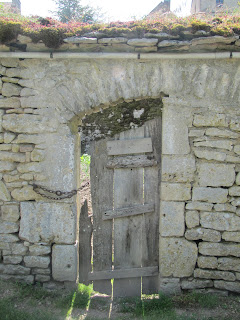This post could be tricky. I have all these lovely photos of a "Plus Beau Village" called Flavigny, just 40 minutes north of us, but I didn't go along to visit this town so my comments are second-hand.
Flavigny calls itself a Cité Médiéval et Gourmand en Bourgogne," a medieval and gourmet city. It belongs to an exclusive organization called Most Beautiful Villages (of France). Small villages of less than 2000 inhabitants can apply. They must have a rural character and have at least 2 designated national heritage sites. The town council must be in favor of the designation and an on-site evaluation must be done. We've visited many of these villages over the years and they are charming, historic, friendly, and authentic. We enjoy wandering through their streets and alleys, feeling carried back to another time in history.
 |
| Flavigny - Janis Hunsinger Photo |
 |
| The crypt |
 |
| what's left of the facade of the church of St. Pierre |
Flavigny has a very colorful history. In 52 BC Caesar built 3 military camps on this hill top. He gave anise seed to his troops as a treatment for stomach problems. After defeating the Gauls at Alesia, Caesar gave this site to one of his veterans, Flavinius, for whom the town is named.
Vikings (Normans) invaded the area in the 9th century at which time the relics of Saint Reine d'Alise were transferred to the abbey for safe-keeping. The abbey became a pilgrimage destination and the third most important abbey in France. At this same time, Charlemagne ordered that monasteries and convents grow anise.
City walls and gates were built in the 12th century and rebuilt in the 14th century. Maybe the Hundred Years War had something to do with walling in the city.
 |
| Porte du Val |
 |
| Porte du Bourg, 15th century |
From the 16th century on, Flavigny has been known for its anise sweets, small balls of anise coated in sugar, hard as jaw-breakers, but very small. Anise is not my thing, but Dave seems to like it.
 |
| Boutique for les Anises de Flavigny - anise candy |
Some more pretty pictures from Flavigny.
 |
| three abbeys milestone (see below) |
 |
| three abbeys milestone (see below) |
Home in time for dinner. Dinner tonight is grilled salmon with French green beans, roasted potatoes and salad. Pretty as a picture.
 |
| dining room in La Maison du Capitaine - Ron, Chris, Janis, Clark, Lynn |







It is so easy to imagine Dan and me sitting at your table, enjoying that delicious meal, after visiting a beautiful "village de France" ;-)🤗
ReplyDelete